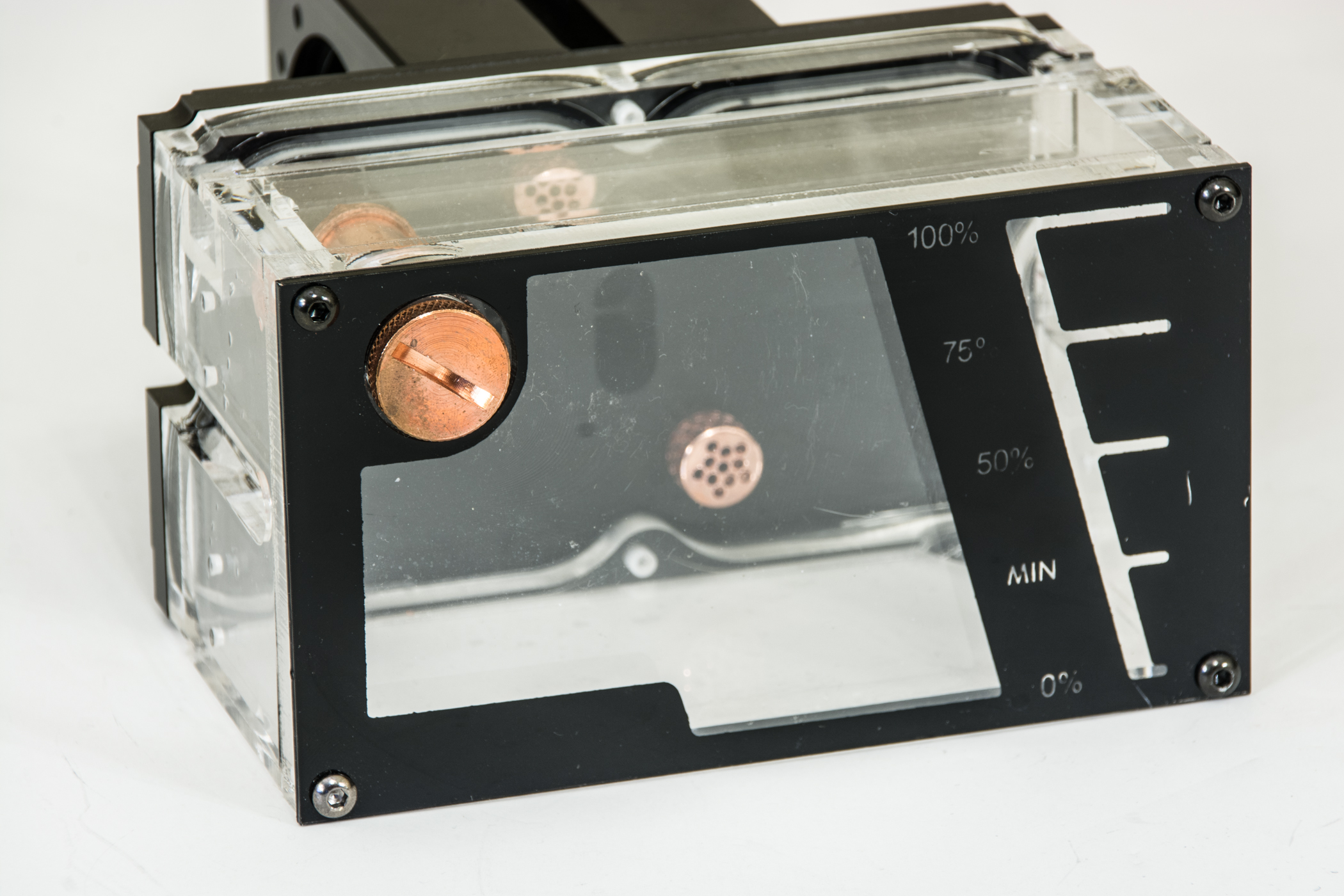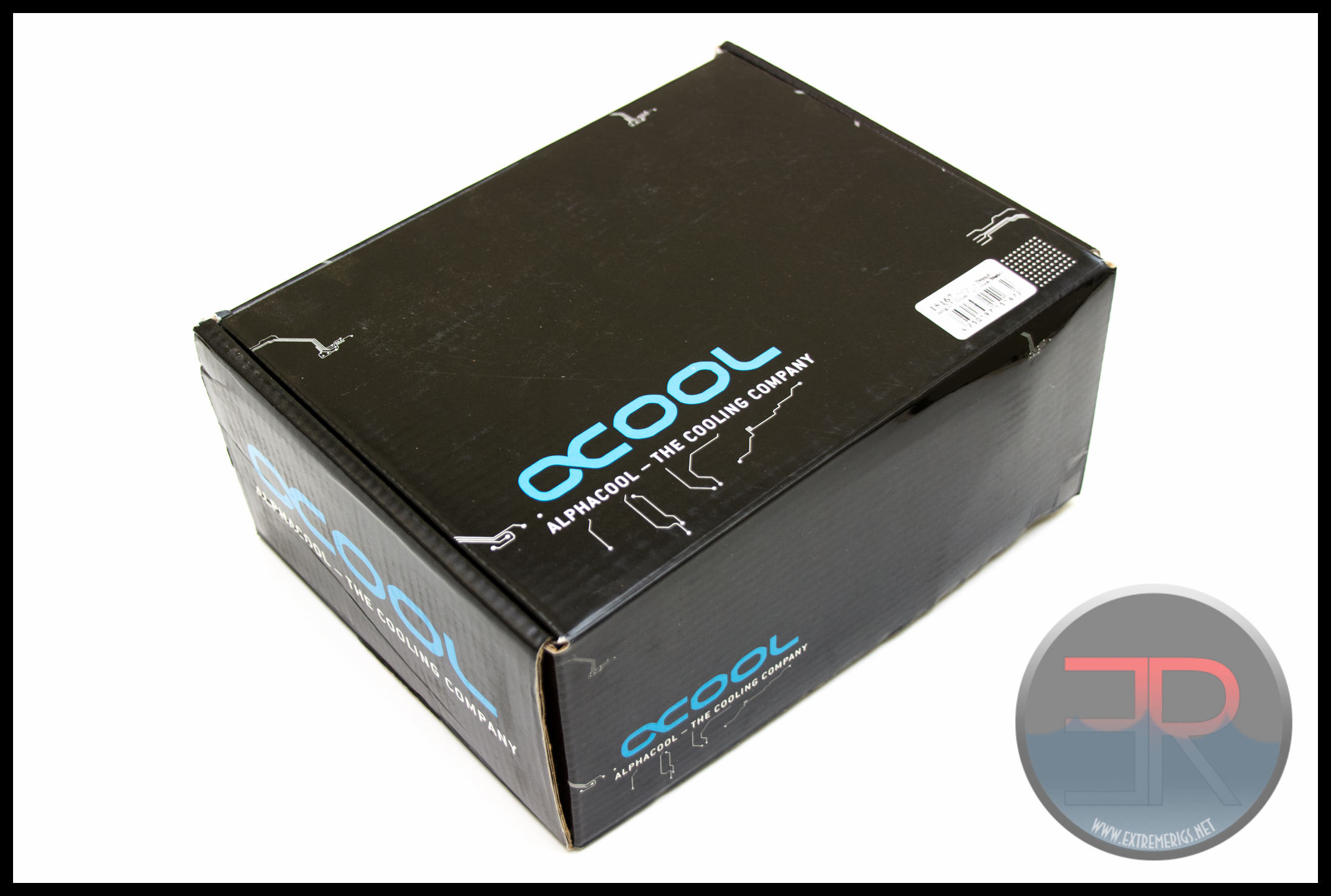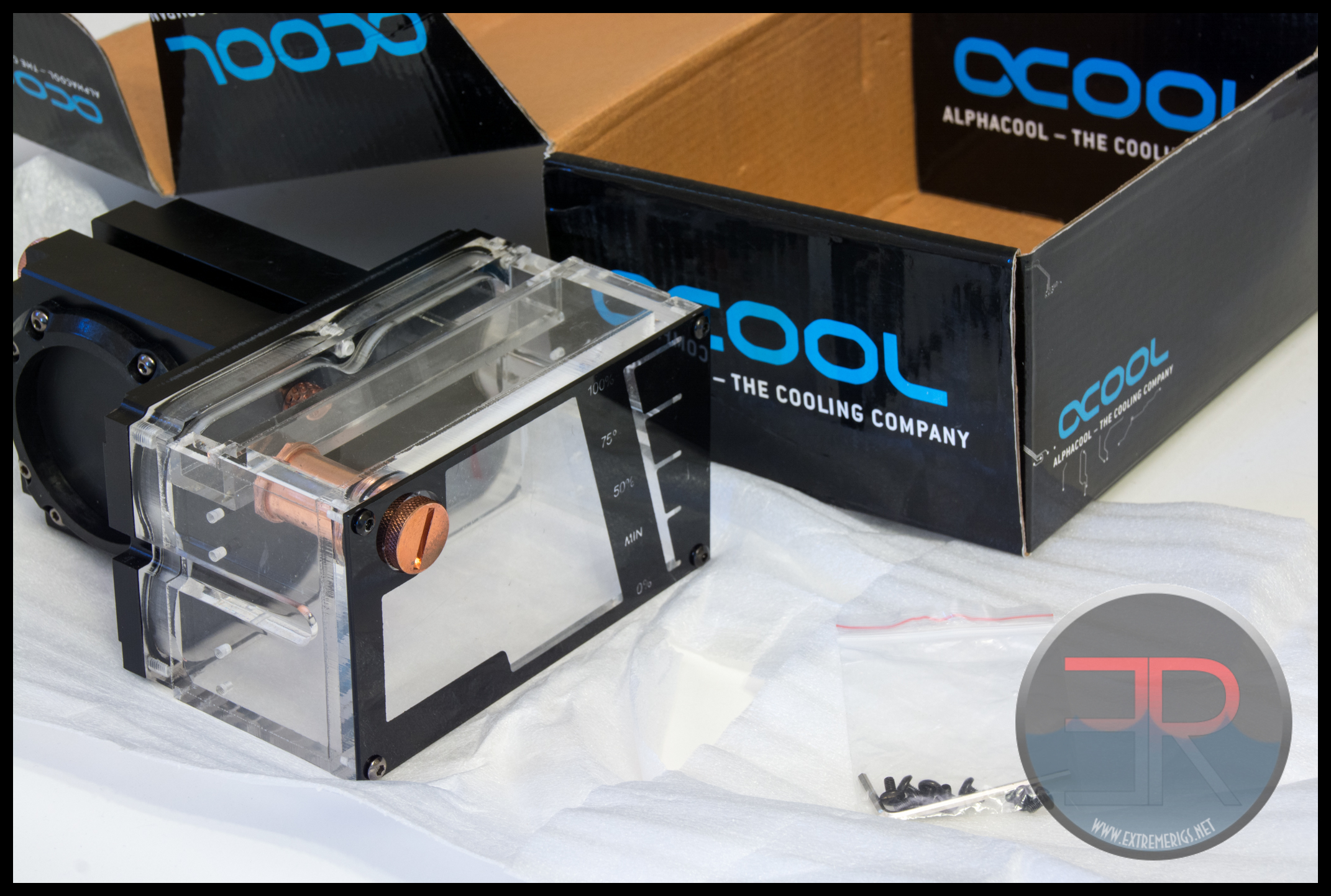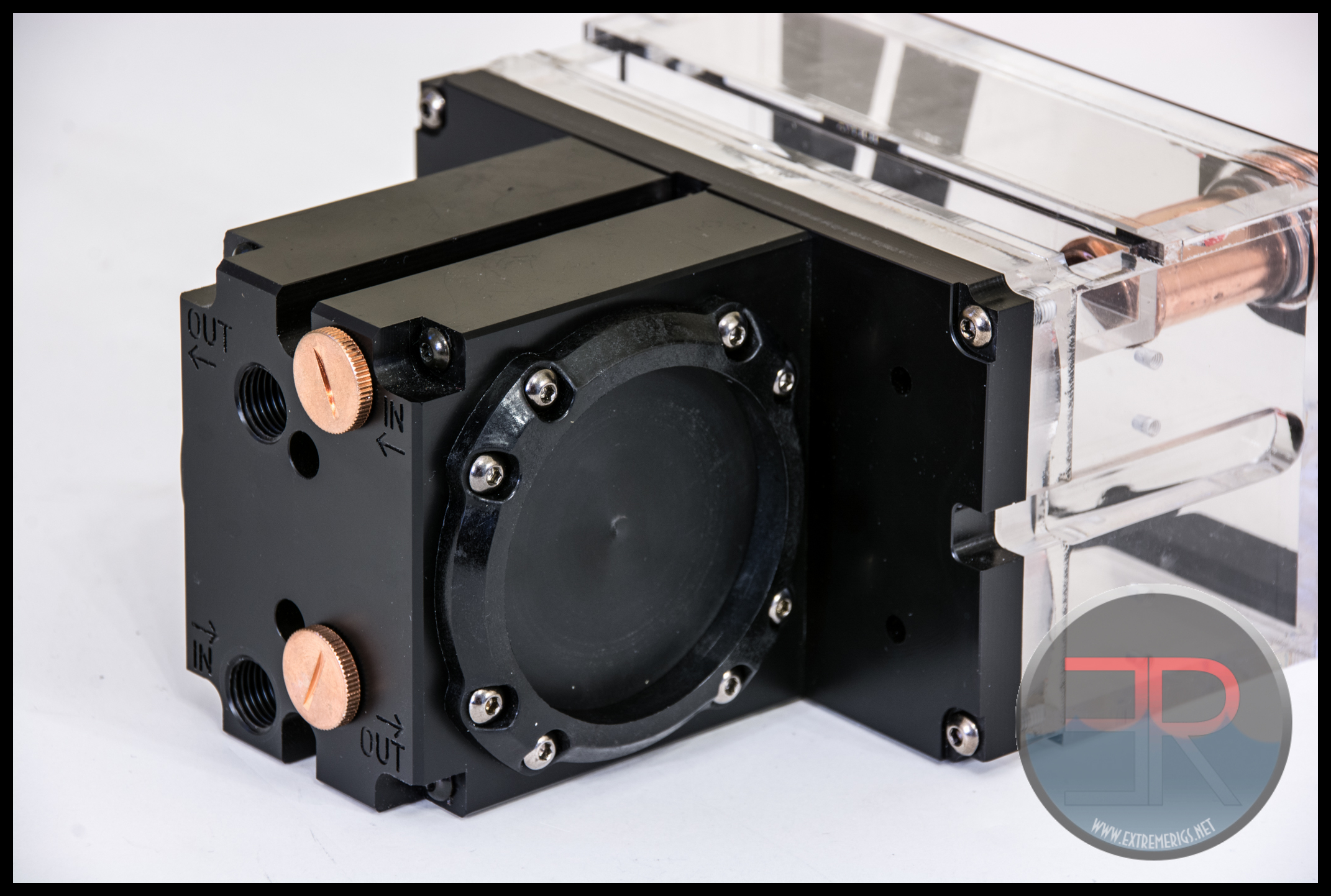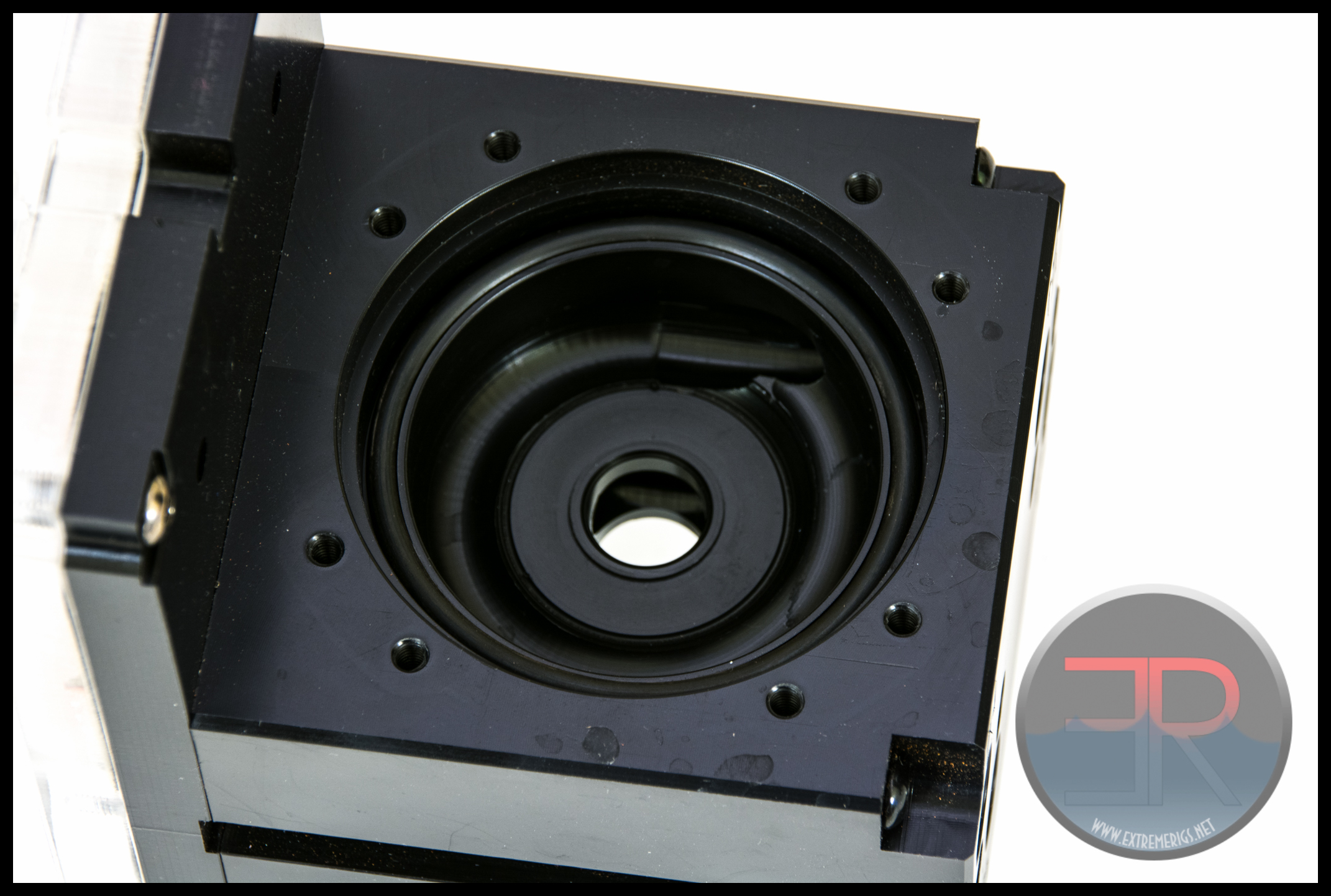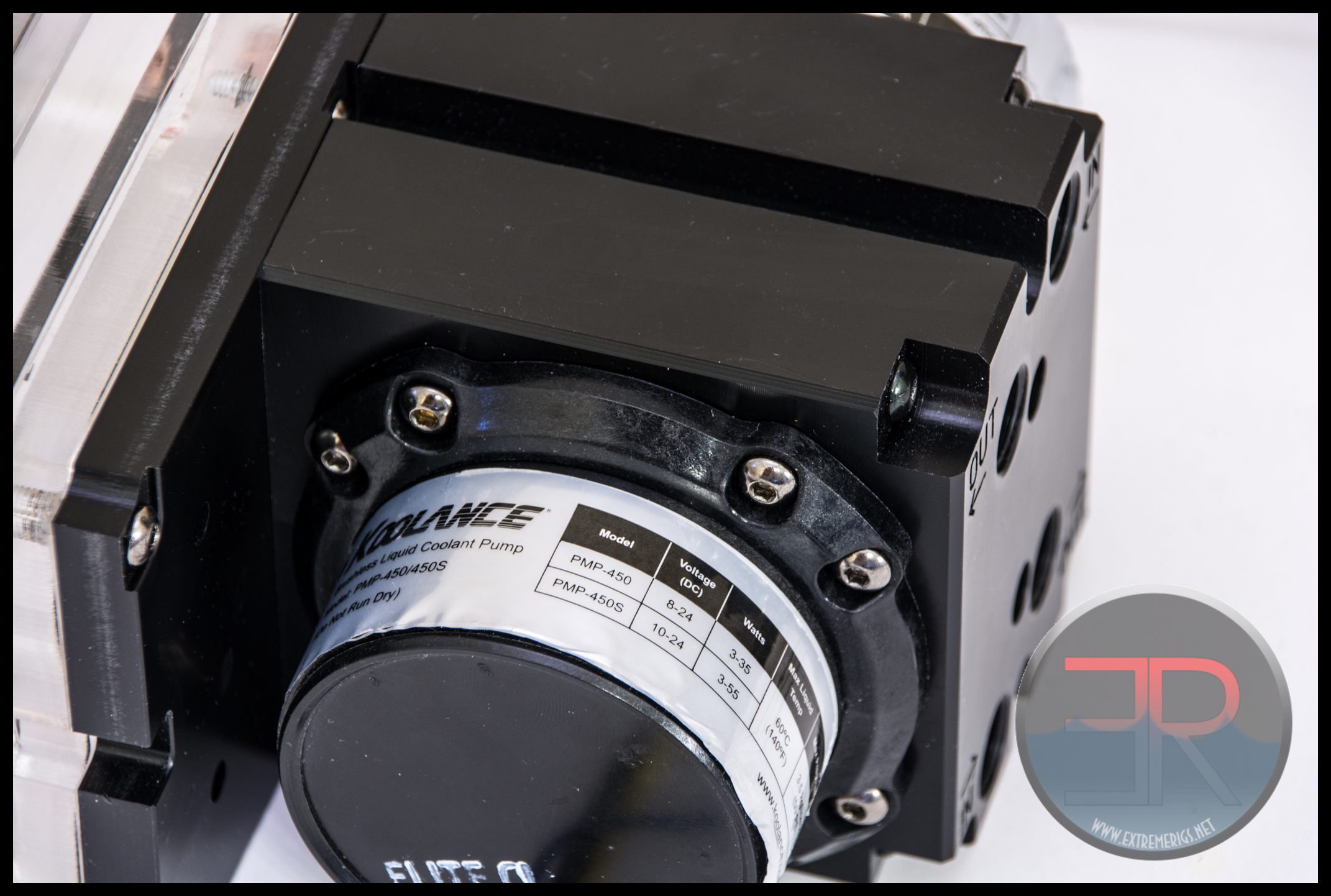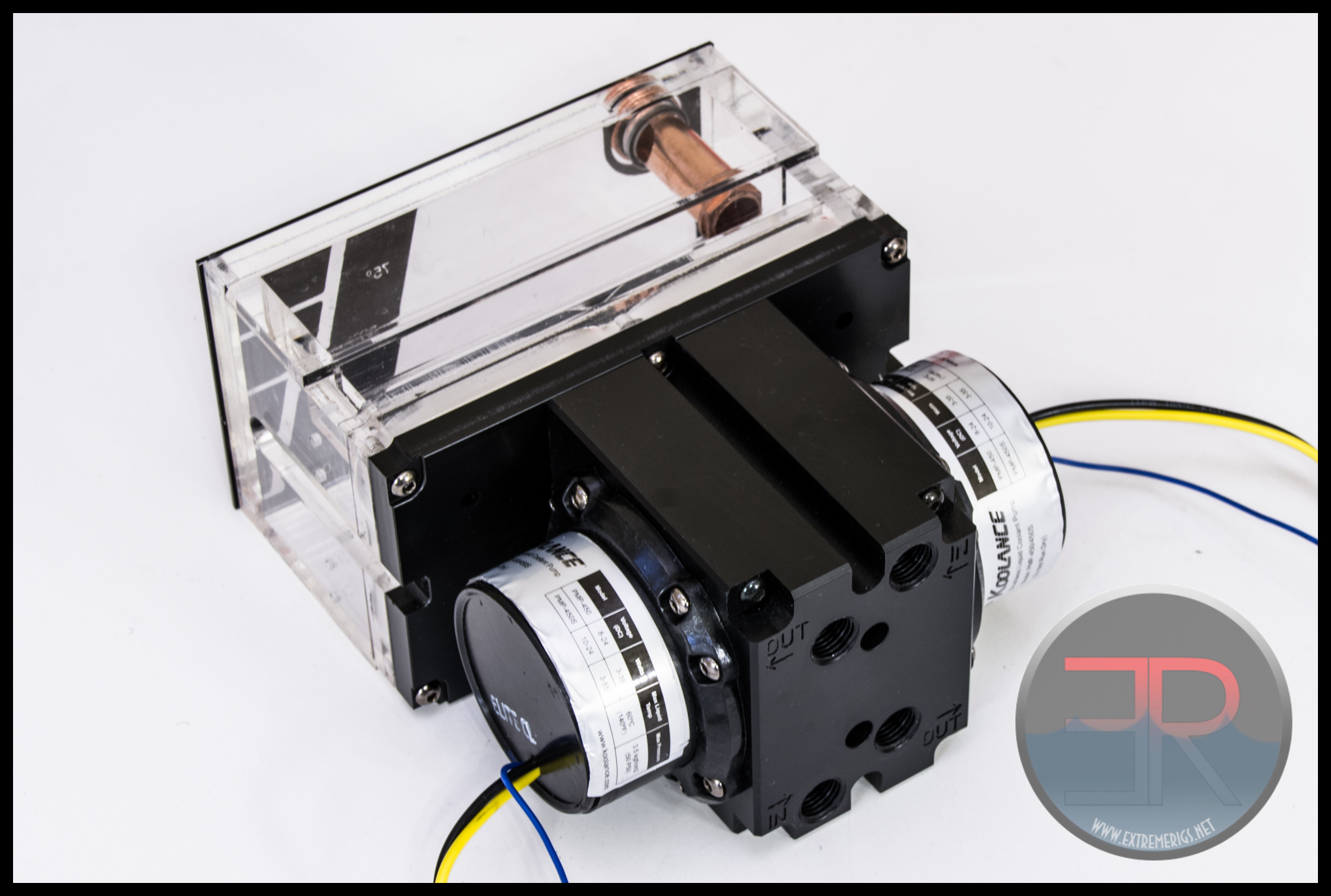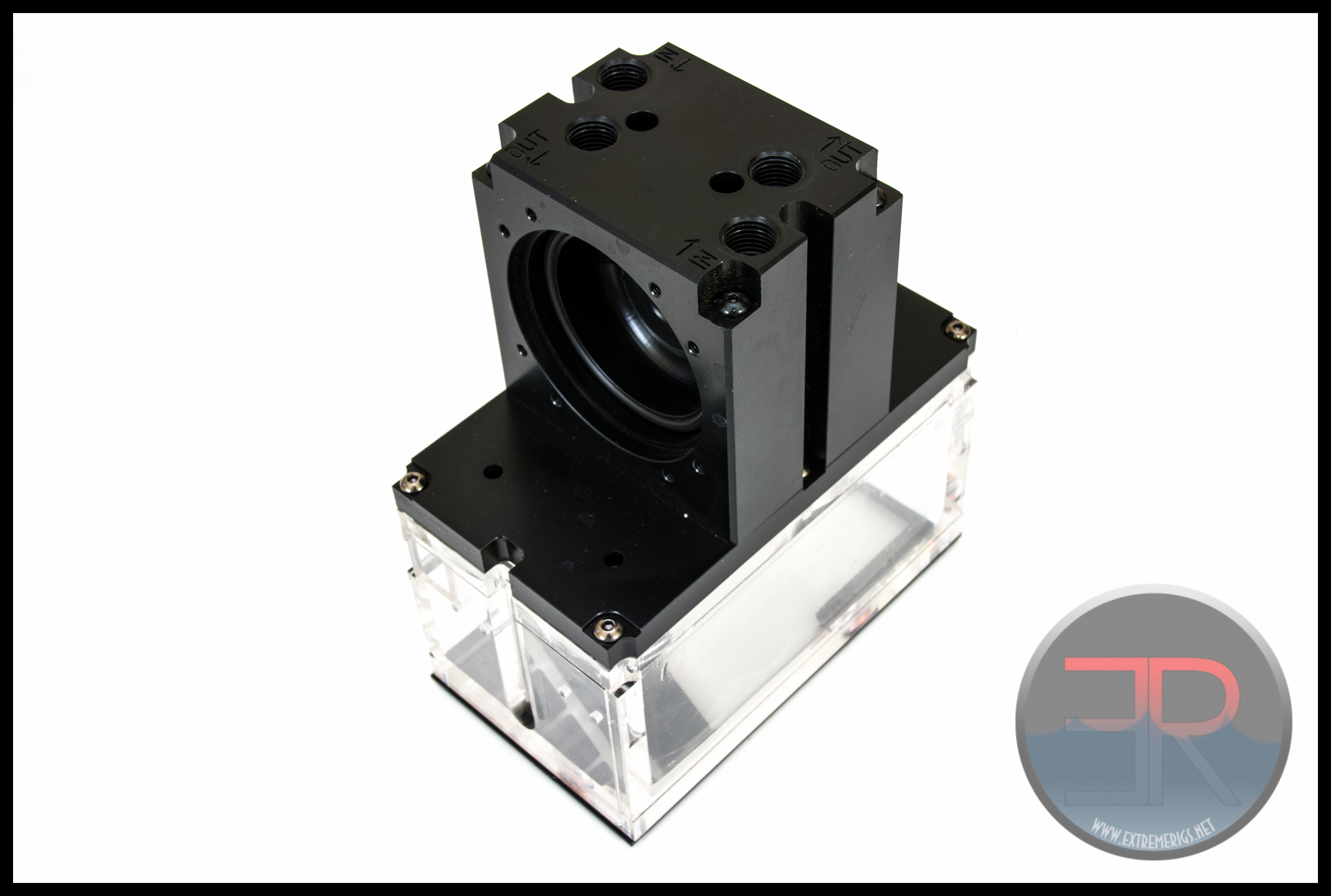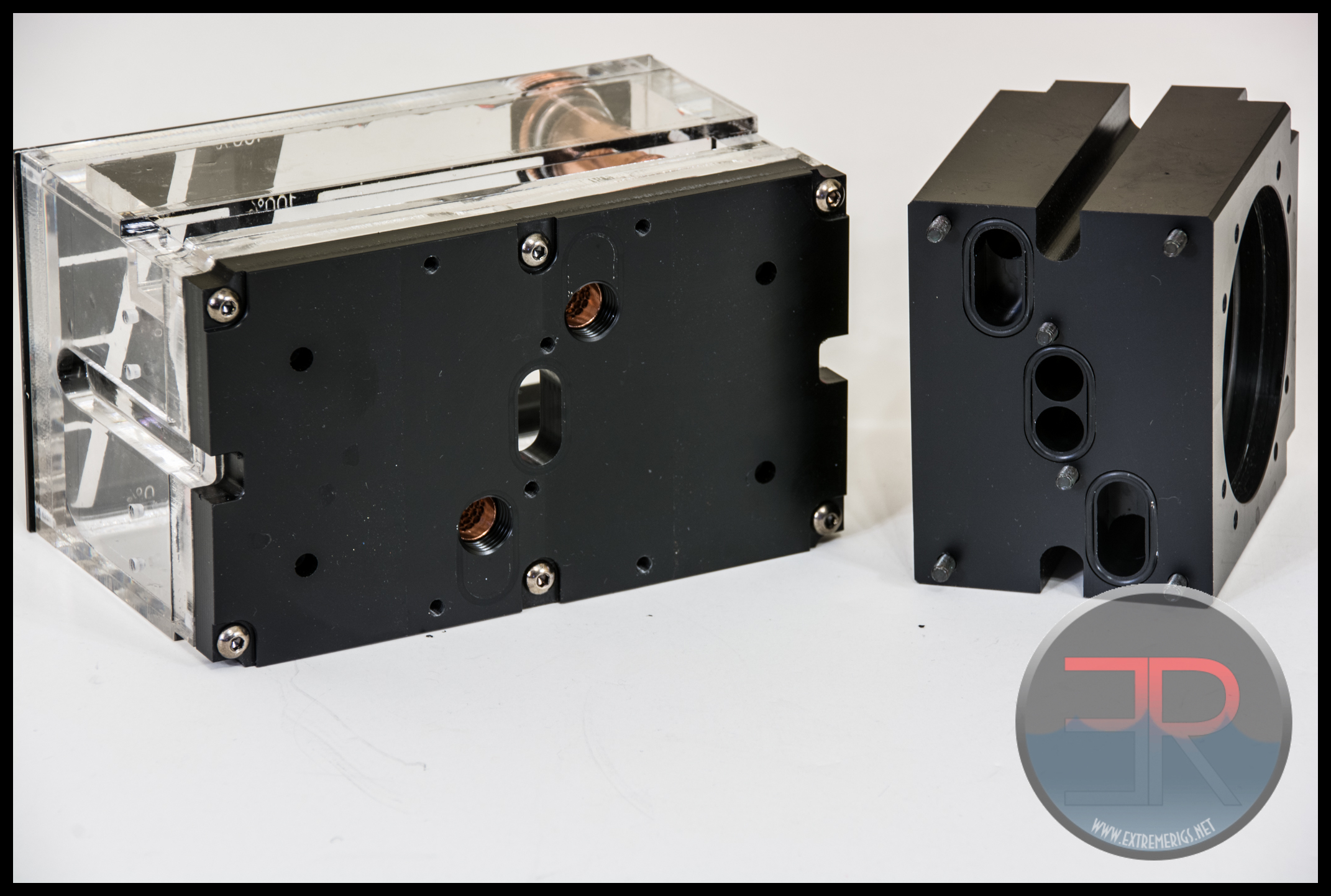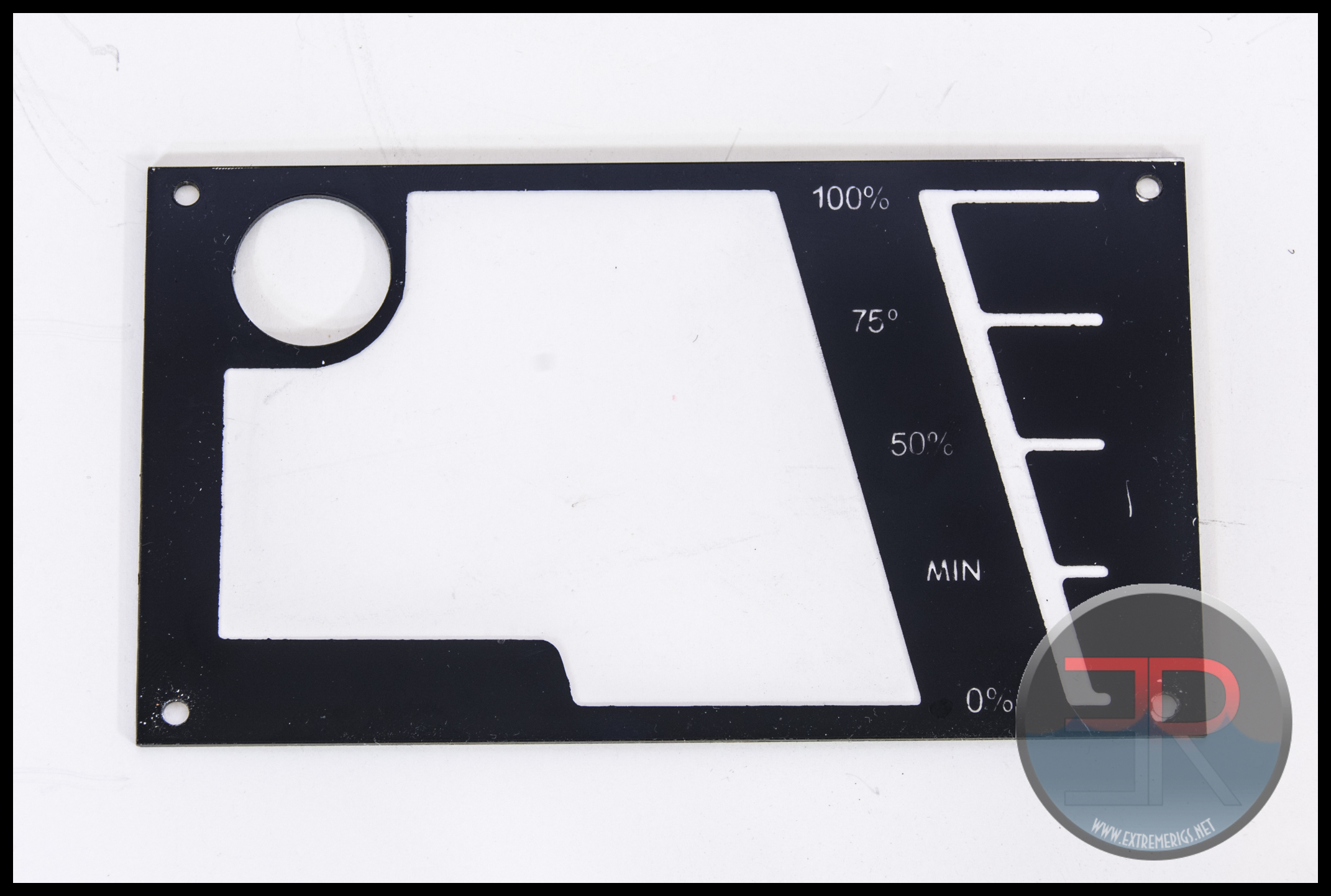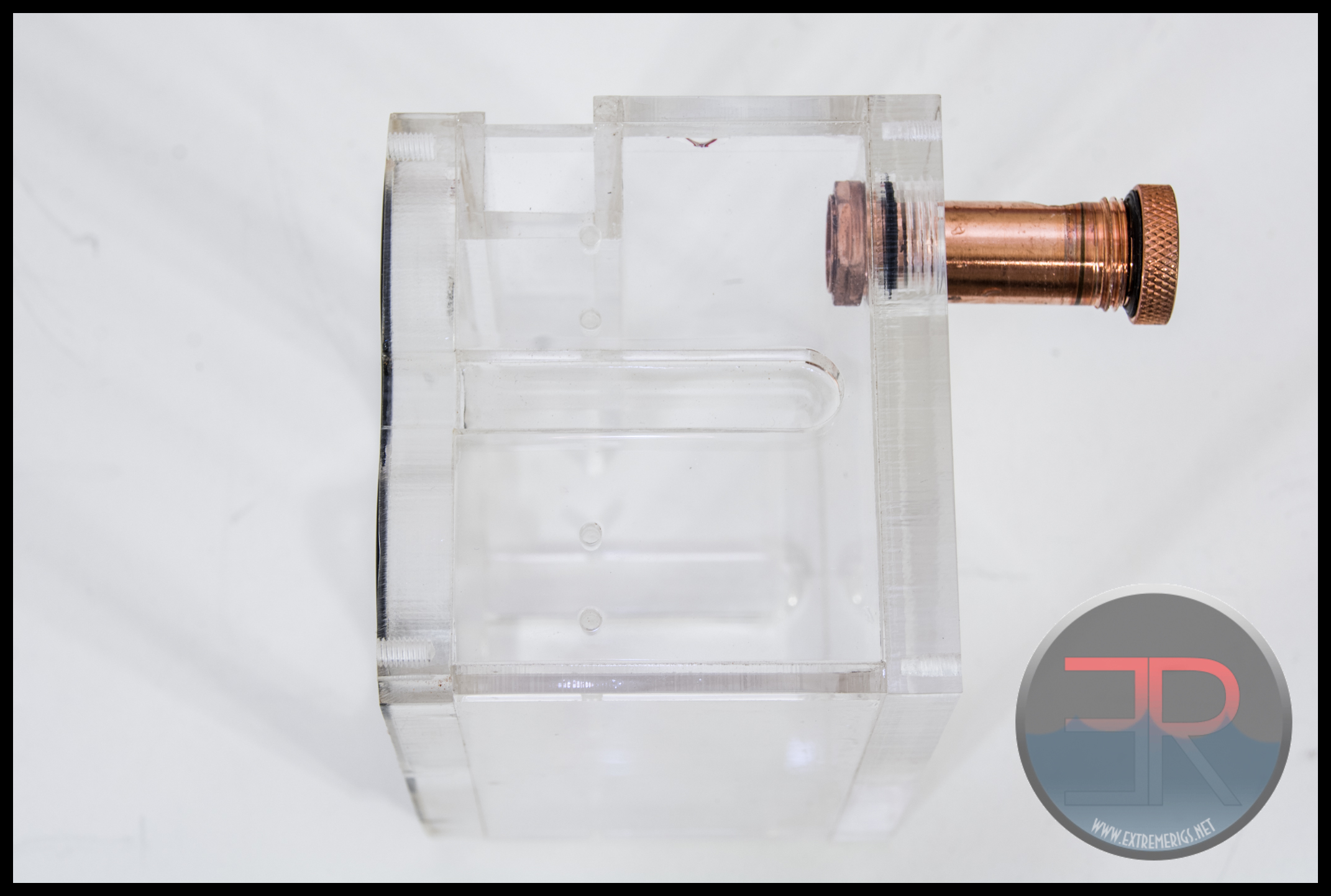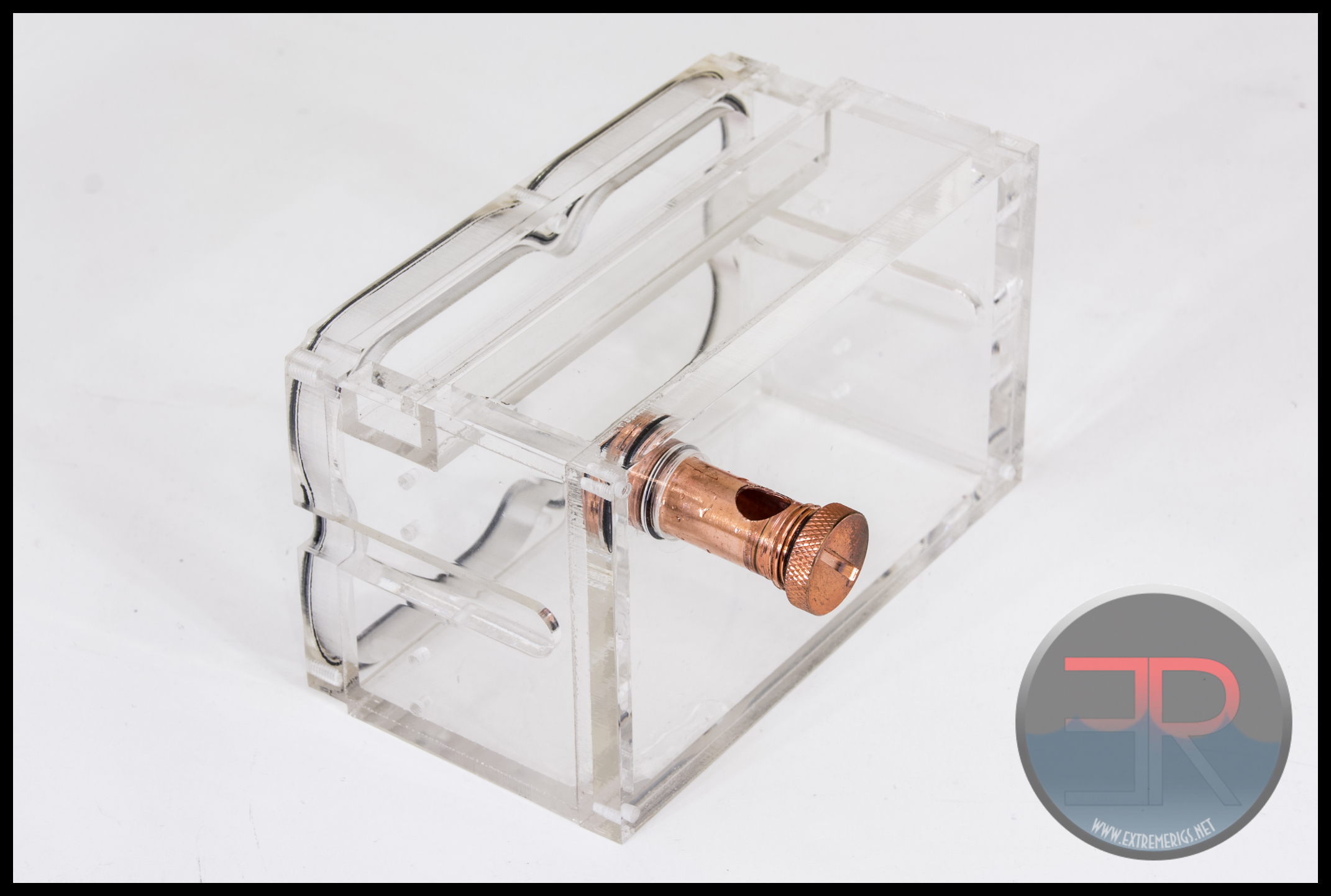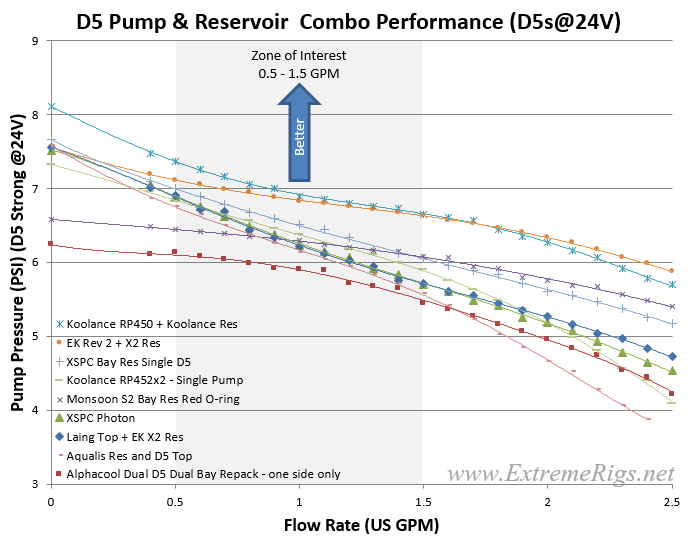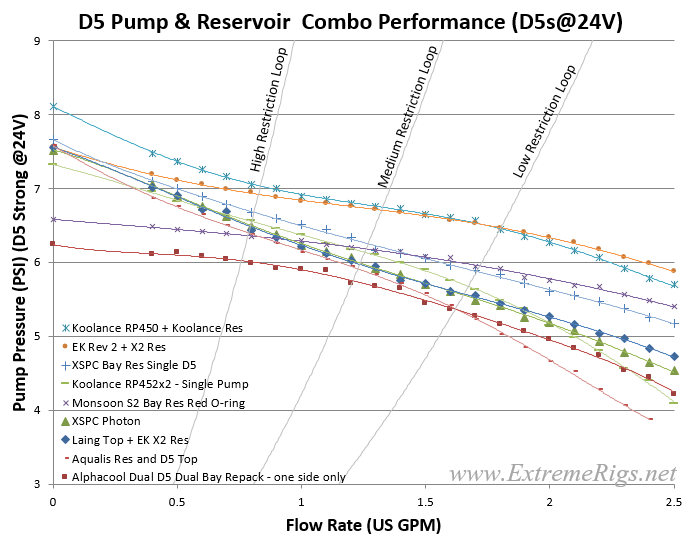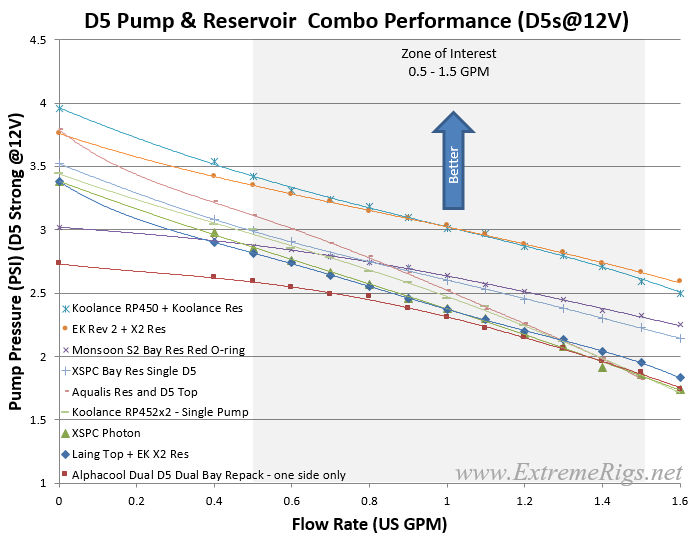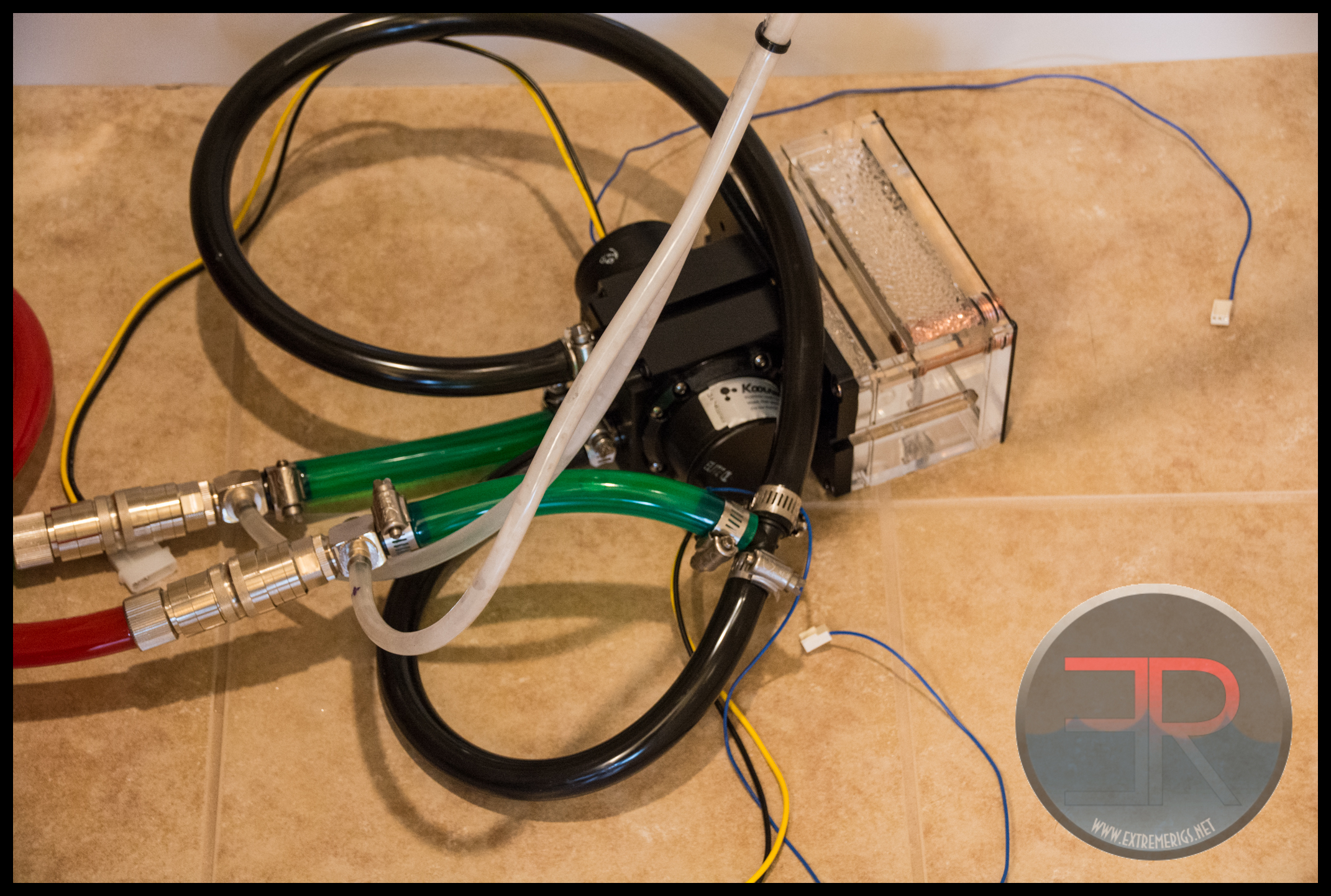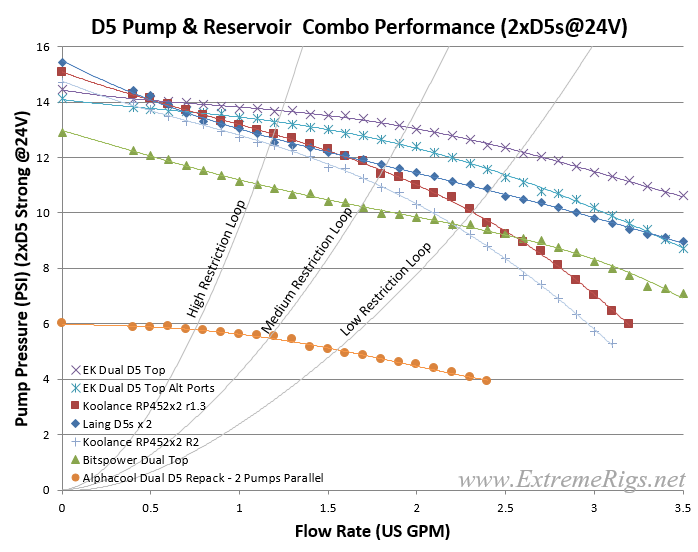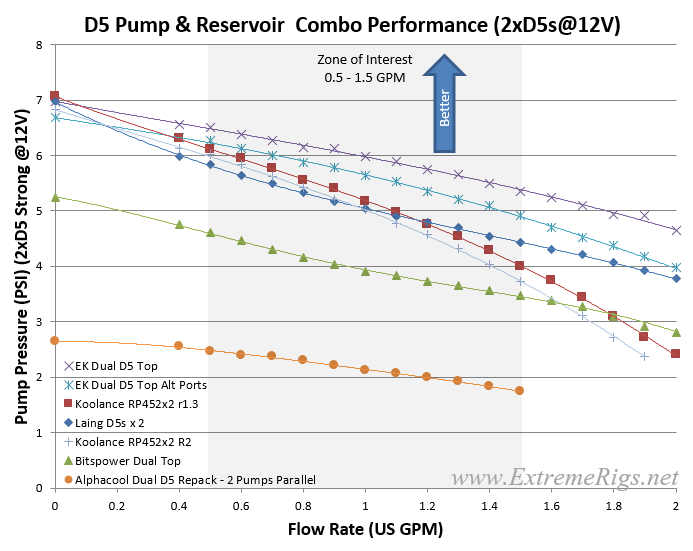Introduction
Alphacool have a dual bay reservoir that also fits up to two dual D5’s. This is similar to the Koolance RP452x2 that we recently covered but has some very important differences.
The box is consistent with Alphacool’s usual style. Although the reservoir itself was wrapped in a thin foamy sheet, we didn’t feel that alone it was really sufficient to protect the reservoir from being accidentally dropped. We’d like to see the protection increased. Inside the box you get the unit itself as well as mounting screws and an allen key to mount the pumps and reservoir:
Instructions are not provided. Indeed if you are unfamiliar with how to mount a pump then you might be a little lost. However it’s not hard. Unlike the Koolance RP452x2 dual bay dual D5 reservoir this is not a setup that can be used as any combination of setups. The reservoir must be shared. The pumps can not be put in series despite the website claiming that this is the case. Indeed when Alphacool states that a series setup can be used they actually mean two pumps in parallel. Even for this case, the required Y adapter is not included.
You might assume that a series setup can be acheived by simply connecting the input of one pump to the output of the other. However because the reservoir is shared and can not be isolated from one of the pumps it means that one pump in this setup would end up with input and output connected to the reservoir. In other words you would end up with one pump spinning it’s wheels kicking up turbulence inside the unit while the other pump struggles to actually drive the loop. We tried this and needless to say it hurt performance significantly.
Out of the box the unit is setup with one pump mount closed off so that the unit can be used with only one pump. Indeed you can buy the unit with 0, 1 or 2 pumps prefitted if you wish. Because the o-rings are supplied you can buy the cheaper “bare” version of the Laing D5 pump that comes without the standard Laing top or o-ring. It should be noted that any D5 pump will be compatible. You do not have to use an Alphacool rebrand of the D5.
Pumps can be fitted by removing the lock ring and if fitting two pumps then the blank plate should also be removed. Note that the two pump inlets are shared. While this provides less restriction to the pumps by sharing a wider inlet it does mean that each pump can feedback into the other. It does however mean that the pump blank piece can be removed easily by poking a screw driver through the other side’s inlet:
The pump is then secured with the provided clamp (make sure the o-ring is fitted first) which is secured with 8 screws:
The 8 screws give plenty of confidence and the setup did not leak (unlike the Alphacool D5 pump top we tested). Indeed the acetal fit around the D5 was so tight it was hard to remove the pump afterwards.
There is just enough clearance for the wires to bend from the base of the D5 before they would hit the walls of the 5 1/4 bay.
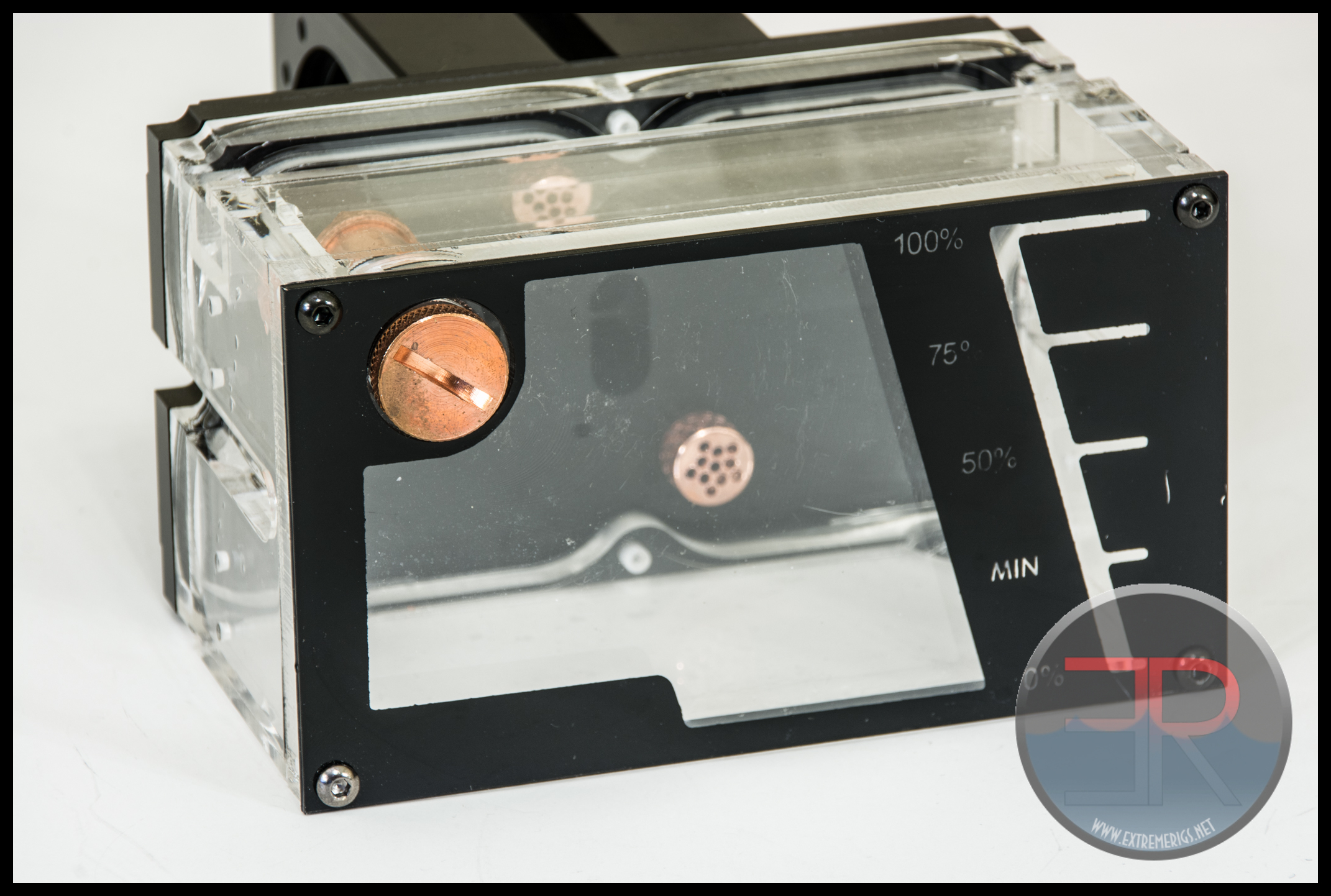 The unit uses a plexi cover with black markings on it to show approximate water levels that do not really correlate to the actual minimum levels of the unit. It should be noted that one of the four screws that mounted the plexi cover was a different color and length to the other three. In the top left there is a fill/bleed port which does not fully remove but is meant to be used with Alphacool’s filling syringe thing.
The unit uses a plexi cover with black markings on it to show approximate water levels that do not really correlate to the actual minimum levels of the unit. It should be noted that one of the four screws that mounted the plexi cover was a different color and length to the other three. In the top left there is a fill/bleed port which does not fully remove but is meant to be used with Alphacool’s filling syringe thing.
On to construction…
Construction
The unit is composed of multiple parts:
The pump mount area is removable and is fixed with 6 long screws and seals with three o-rings and attaches to another acetal piece which forms the back of the reservoir itself:
Note that there are four holes drilled partly through the acetal back. They look like they are for LEDs but that would require this piece to not be made of acetal.
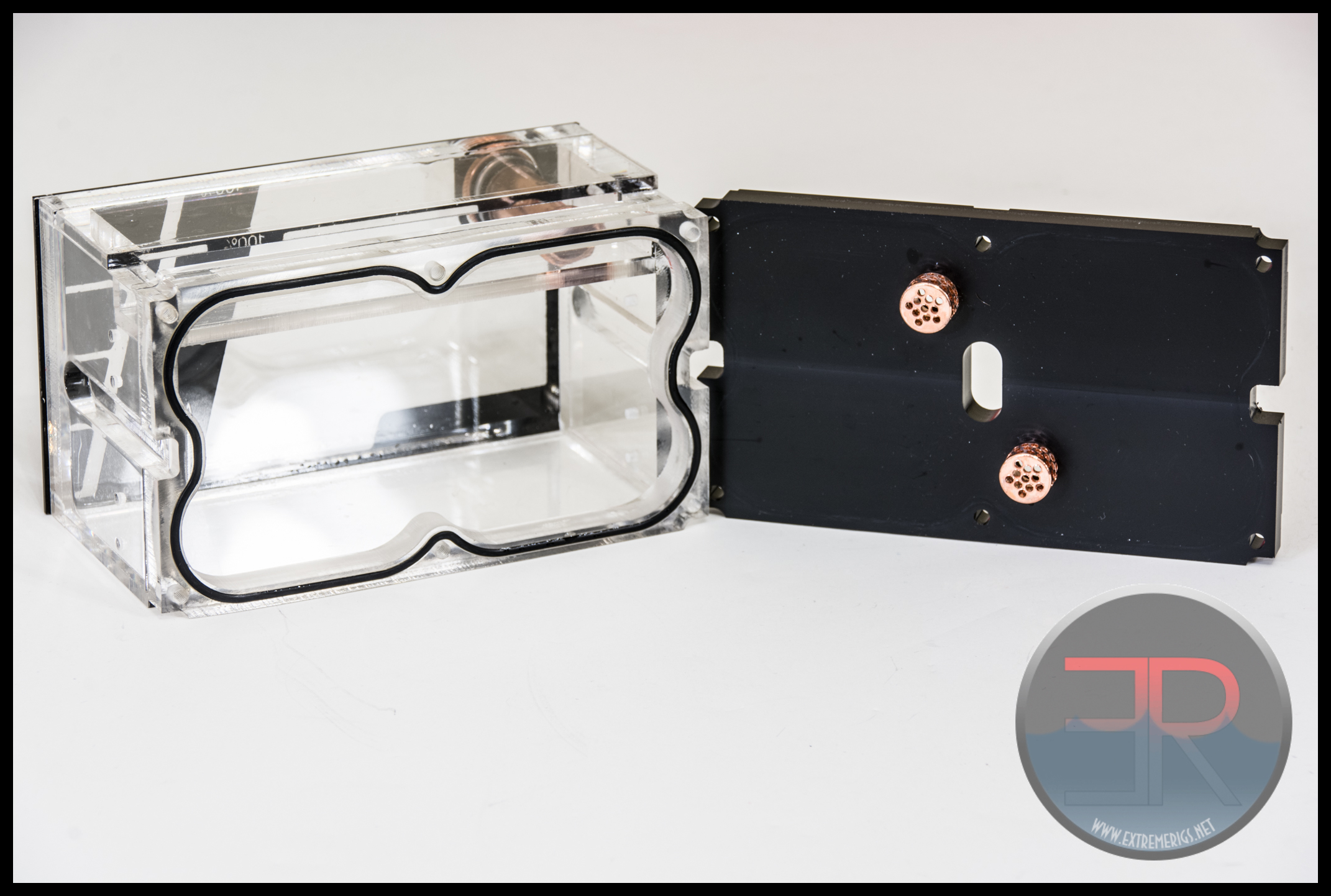
The copper pieces screw into the acetal and are designed to help separate bubbles from the return coolant. The rest of the body of the reservoir is made up of multiple glued pieces of acrylic. Glue is of course not our favorite element to use on reservoir construction. It may fail over time and requires good joins on multiple sides. This reservoir further complicates the construction by using more than the 5 pieces you might assume:
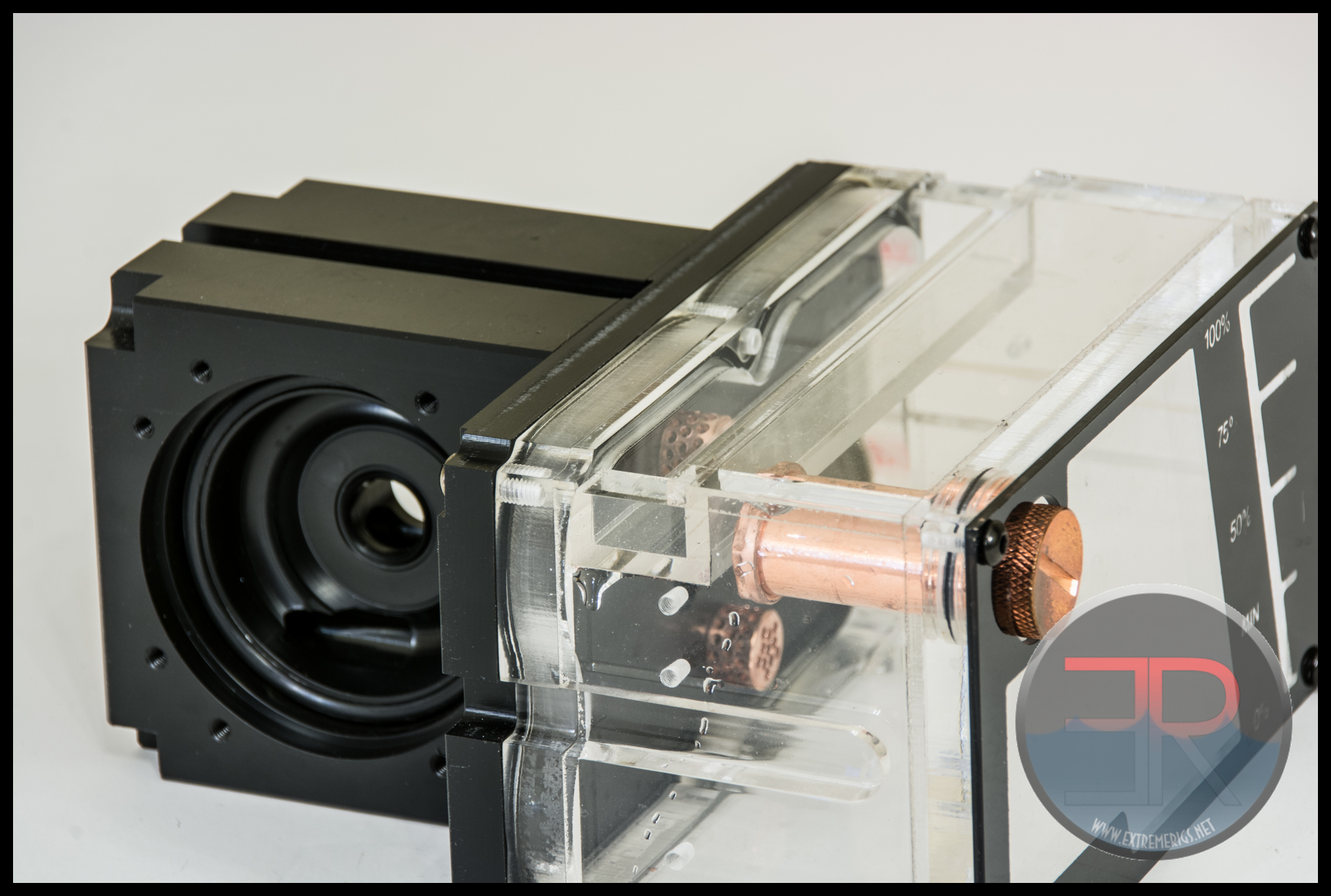 There is a bubble shield which require another three pieces of thinner acrylic to be glued together. In addition there is a back piece to the reservoir to give a flush mount to the o-ring and the acetal making a total of 9 pieces of acrylic and something like 22 joints.
There is a bubble shield which require another three pieces of thinner acrylic to be glued together. In addition there is a back piece to the reservoir to give a flush mount to the o-ring and the acetal making a total of 9 pieces of acrylic and something like 22 joints.
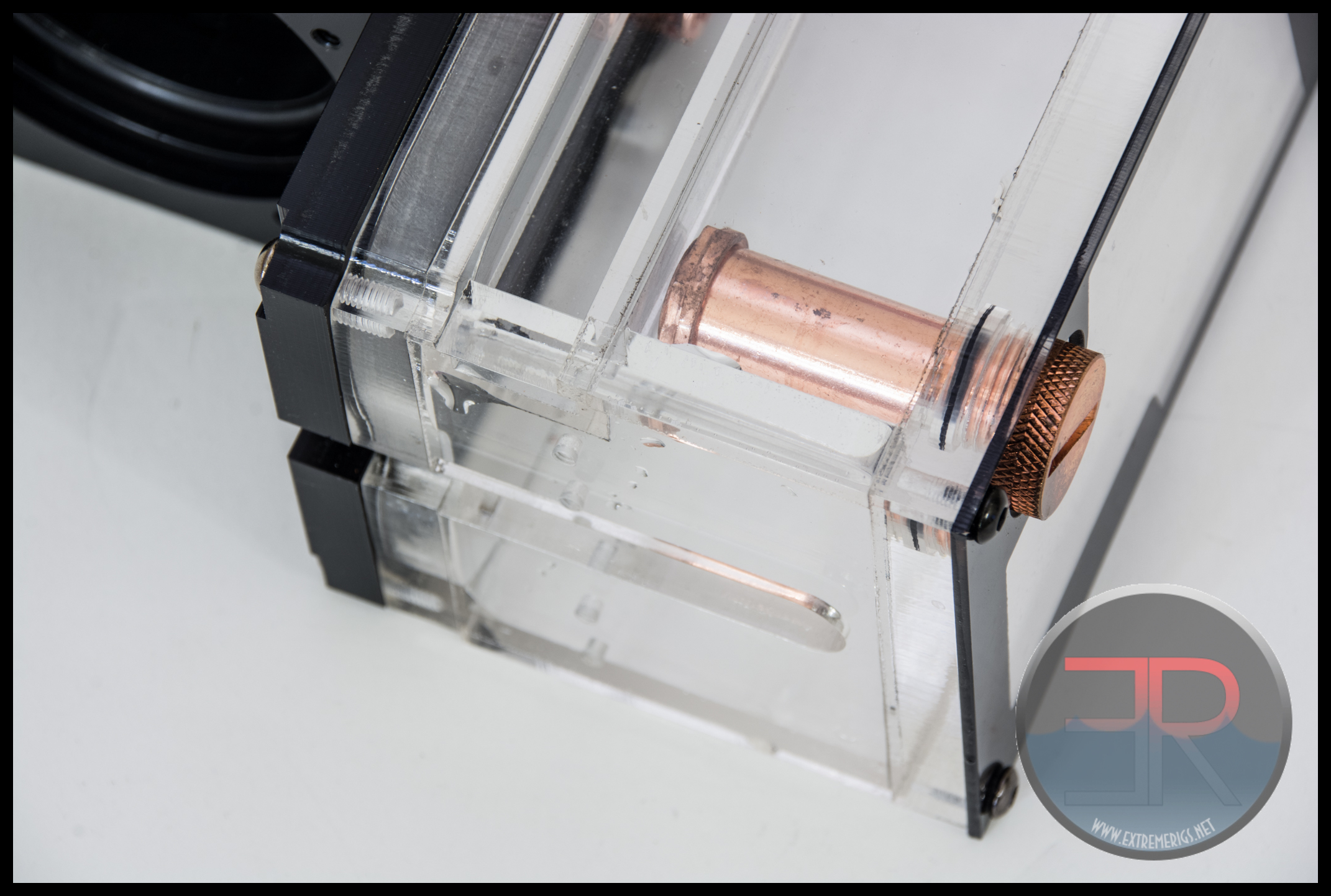
In addition the acrylic is drilled into and threaded so that screws can screw into in 18 places. Contrast this to the (albeit more expensive) Koolance reservoir that never glues or screws into the one piece of acrylic that seals the unit.
The faceplate is not as attractive either, it could have been cut out of Aluminum like Koolance or XSPC does, instead it’s printed on a piece of acrylic that end up giving a cheap look. The markings are ugly and the minimum level is actually below the input to the pumps.
The bleed valve is not fully removable. It does help to fill but only if you have the required and not included filling device. Personally I’d rather have two standard G1/4 fittings. The copper fitting is also not lacquered so it can and does tarnish over time.
The machining is of acceptable quality but the design is just quite simply poor. There are no options to break the reservoir into two units, nor to enable the pumps to run in series. The many glue joints are a known weakness that might fail over time, and the screw threads into the acrylic will be easy to strip.
So clearly it’s poorly designed and thought out, but what about it’s performance?
Performance
As it’s a dual pump setup we must test it both as a single pump setup and with two pumps. First let’s test it as a single pump. For how to read a pressure/flow plot check out our guide.
For these tests we measure the pressure gain across the unit with a D5 strong fitted and vary a faucet/tap to control the flow rate. The D5 strong at 24V gives the absolute maximum performance that could be extracted from the unit:
Most users run around 0.5-1.5GPM of flow. Here we can see that the Alphacool is below the rest of the competition slightly. To see how much we need to plot a load line based on the restriction of our loop:
Although behind the competition the actual effect on flow rate is only around 10-15%. Of course due to noise concerns most users don’t run a D5 strong at 24V but instead use a D5 vario set at setting 3 or 4. A D5 strong at 12V corresponds roughly to a D5 vario at 3.5, so we also measure this setting:
As can be seen the Alphacool is still at the bottom and only provides acceptable ~1GPM performance with a low restriction loop:
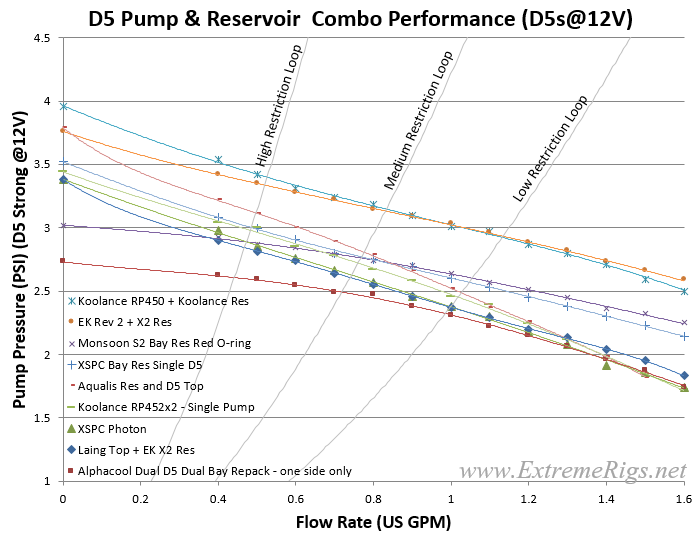 On to dual pump performance..
On to dual pump performance..
Dual Pump Performance
For dual pumps you could run two parallel loops, each receiving one pump with a shared reservoir. Due to the symmetrical nature of the design the performance of each setup will be identical to the single pump performance already tested. For dual pump testing then we will test with the setup for one loop. This is where the Alphacool does not shine. Unlike the competition, it does not allow a true series setup where one pump’s output feeds *only* the input of the second pump. The only way to hook up this reservoir is to run both pumps with one loop is to hook them the pumps up in parallel. This is because the pump inlets can not be isolated from the reservoir. Martin showed that series is always better than parallel in this great article.
As the necessary Y connector was not included we had to use a T connector that we had lying around:
This is less than ideal because the two pump output are directed exactly towards each other, in other words they are providing back pressure to each other and this shows in the data:
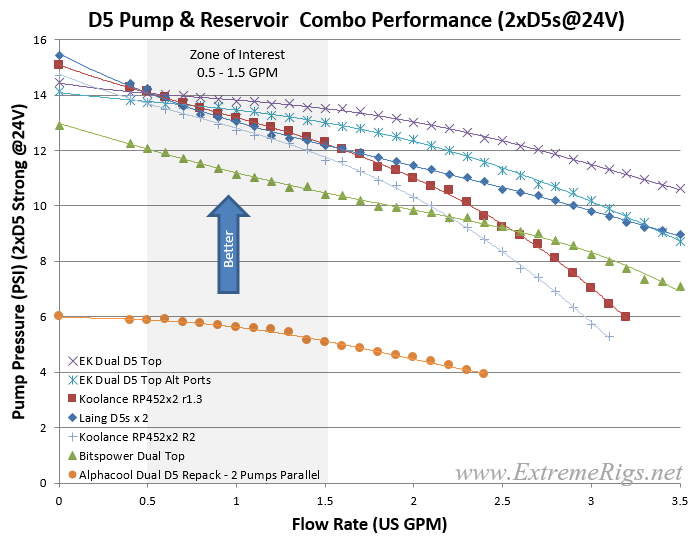 With two D5 strongs at 24V the Alphacool is miles behind the competition. Now instead of being 10-15% behind in flow it is more like 40% behind.
With two D5 strongs at 24V the Alphacool is miles behind the competition. Now instead of being 10-15% behind in flow it is more like 40% behind.
Bear in mind this performance was actually worse than the single pump performance on it’s own! In other words you get less performance by adding on the 2nd pump and using this kind of T adapter.
Lowering the pumps to 12V shows the same behaviour:
Even with a low restriction loop, the Alpahcool can not hit 1GPM with 2xD5 pumps.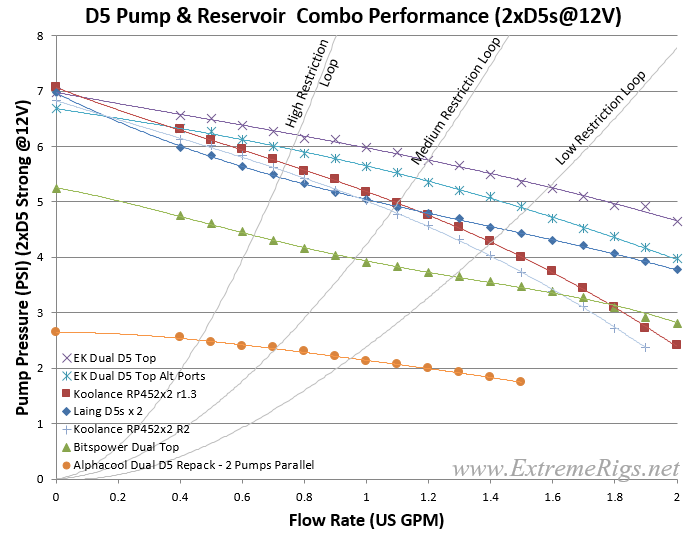
On to the Summary
Summary
Performance – 1/5
There are three reasons to run multiple pumps:
1. To improve performance
2. To reduce noise by maintaining performance and running pumps at a lower speed
3. To add redundancy and maintain system operation after a pump fails
The Alphacool repack completely fails at 1 and 2. The only use model therefore is to be used for two parallel loops with a shared reservoir. Even if you used it for two parallel loops then it might be useful to have separate reservoirs so that you can fill and maintain each loop separately. Even when we ignore all of this, the single pump performance is still behind the competition.
Features – 2/5
This setup is so far behind what the Koolance RP-452×2 can do that it should even be considered in the same league. For example the reservoir is always shared, pumps can not be setup in series, there is no secondary fill port. For a parallel setup the required y adapter is not included. The minimum fill line on the front plate isn’t even correct. LED’s are not included, nor can they be fitted later. There are no vibration reduction mounts.
Quality – 2.5/5
While the acetal parts are machined acceptably, and the cast nylon pump rings are strong, the use of so many pieces of acrylic that are then glued together is a huge weakness. In addition screwing into acrylic is hardly desirable either. Having said that, it didn’t leak or crack even when subjected to two maxed out D5 strongs. I also didn’t strip any threads.
Aesthetics – 2.5/5
Aesthetics are in the eye of the beholder. I’ve never been a huge fan of Alphacool’s black and copper look. However the front plate just looks a bit cheap and in addition one of the screws that secured it didn’t even match. The best looking part of the design is the back which would never be seen.
Value – 3/5
At $106 with no pumps, it’s slightly cheaper than the better designed, better performing and better quality $130 Koolance RP-452×2. However once you factor in the cost for two D5 pumps then the price difference is small relatively. If you’re using it only for one pump the XSPC Dual Bay D5 unit is cheaper still.
Conclusion – Avoid!
A poorly designed, poorly performing dual bay d5 unit that can not be used in one of the modes that many users would wish to use it. If you need two pumps in one unit dual bay unit then please please please spend the extra and buy the Koolance.
Where to buy – $106 no pump version here, or $173 with 1 pump, or $246 with 2 pumps fitted.







